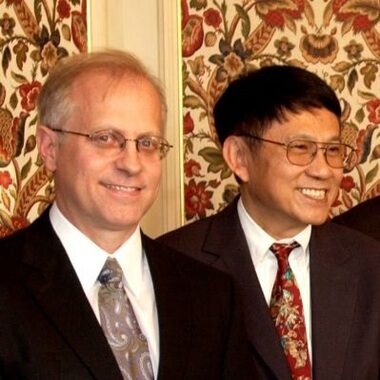Ho-kwang Mao: Dankesrede – Bern, 11.11.2005 (englisch)
USA - USA/China
Russell Hemley und Ho-kwang Mao
Balzan Preis 2005 für Mineralphysik
Für ihre bahnbrechenden gemeinsamen Arbeiten über das Verhalten von Mineralien unter extremen physikalischen Bedingungen. Als produktives Team haben Russell Hemley und Ho-kwang Mao mit ihren Arbeiten bedeutungsvolle wissenschaftliche Beiträge auf höchstem Niveau geleistet. Sie haben Methoden entwickelt, welche die Untersuchung des Verhaltens verschiedenster Stoffe – wie Wasserstoff, des am weitesten verbreiteten “Minerals” des Universums – unter extremen Bedingungen von Druck und Temperatur erlauben. Die Ergebnisse der Arbeiten von Russell Hemley und Ho-kwang Mao sind für unser Verständnis der Natur und unserer Erde von grundlegender Bedeutung.
Mr. Federal Councillor,
Balzan Foundation Committee Members,
Ladies and Gentlemen,
It is a great honor that Rus and I are awarded this wonderful prize. We greatly appreciate that the Balzan Committee decided a year ago to honor the field mineral physics with this most prestigious prize. During the past three decades, mineral physics has made revolutionary breakthroughs, and is evolving into a new dimension in physical sciences. In the earlier days, the term mineral physics was seldom used, and only meant some physics aspects of mineralogy, in distinction to the prevailing descriptive mineralogy. After the plate tectonic revolution in the 1960s, it became necessary to extend our attention from the two-dimension surficial geology to the third dimension at depth for understanding the root of the plate motions. Seismic tomography, geodynamics, deep Earth geochemistry were developed. A very important component is the study of myriad phase transitions and new phenomena of minerals under the enormous pressure and temperature conditions that dictate all processes in the deep interior. Exploration of mineralogy in the new high-pressure dimension became the main scope of mineral physics.
In this exploration, we need apparatuses to reach the pressures and temperatures and methods for in situ investigations of mineral properties. Diamond-anvil cell and a battery of electric, magnetic, X-ray, and optical probes using laser, synchrotron, and neutron radiations were developed and applied. Equally important, we need the knowledge of fundamental physics and chemistry in the new pressure dimension which was largely unexplored previously. The exploration of mineral physics thus ushered in the emerging high-pressure dimension in the multidisciplinary physical sciences. For fundamental physics and chemistry, novel transitions and states of matter are discovered at every pressure interval. For materials science, new classes of materials are synthesized at high pressures and brought back to ambient conditions for technological applications. For geophysics and geochemistry, in situ measurements of minerals are conducted in laboratory at the high pressure-temperature conditions from deep crust to the center of the core. For planetology and astrophysics, interior conditions of extrasolar planets and warm condensed matter are reached and investigated. For biochemistry and biology, new scenarios of adaptation and evolution are proposed based on high-pressure research. And this is just the beginning.
Unlike other disciplines such as “geophysics,” “geochemistry,” “biophysics,” and “biochemistry” which usually mean the applications of established physics and chemistry principles to geology or biology, mineral physics is a two way street which has a great impact on physics and chemistry by adding the dimension which was developed out of necessity for high-pressure mineralogy. This is truly a multidisciplinary or interdisciplinary science unlimited by disciplinary boundaries.
Most funding agencies usually emphasize the importance of interdisciplinary approach, but in practice unfortunately, the parochial approach of narrowly defining the mission and relevance to a pigeonhole has been a problem. Here I salute the Balzan aim “to promote, throughout the world, culture, science… regardless of nationality, race, or creed.” The high principle defies artificial pigeonholes, including the scientific disciplinary boundaries that we put up ourselves. This is my interpretation of Balzan’s choice of mineral physics this year.
I have been very fortunate to spend my entire career at the Carnegie Institution of Washington which was founded in 1902 by Andrew Carnegie “to encourage, in the broadest and most liberal manner, investigation, research, and discovery, and the application of knowledge to the improvement of mankind”. Scientists are supported and encouraged to pursue freely the directions of their choice. For instance for the two Carnegie departments that I am associated with, no one in the Geophysical Laboratory is actually a “geophysicist”, and the Department of Terrestrial Magnetism is working on every subject from geochemistry, seismology, astrophysics to astrobiology except terrestrial magnetism. After 100-year evolution under the apparently vague but truly broadminded principle, the original mission or name might become meaningless, but the thriving science remains the most fresh, relevant, and efficient.
Of course advancement in the high-pressure dimension is a community effort. I am most grateful to have the opportunity to work with so many excellent researchers. The last time I counted, the total number of co-authors on all my publications reached 394. Adding other people who I have been benefited from, the total must be over 1,000. I was fortunate to enter this field with the guidance of my Ph.D. advisors Bill Bassett and Taro Takahashi, and continue to learn from Bill to this day. I was fortunate to start with my postdoctoral mentor Pete Bell at Geophysical Laboratory on the development of diamond cell. I have been fortunate to enter the scientific partnership with Rus Hemley, and greatly expanded the scope in physical science. I have been particularly thankful to my wife Agnes Mao who retired from George Mason University librarian job and became more than a supporting spouse and more than a research colleague. She actually took over all my scientific chores, including management of research groups, literature searches, correspondence, travel planning, budget and accounting, etc. and made me three times more efficient. Finally, I am extremely grateful, and thank you all very much.
Ho-kwang Mao
